|
Fifth Dimension Catalog Contact Us |
|||

|
Rehabilitation Exercises |
||
|
|||
When you have been ill or inactive for a long time, you may have a difficult time regaining your strength. Your joints may seem stiff and your muscles weak. Your body is suffering from disuse. The longer you remain inactive, the longer it will take to regain your lost strength and return to active living. To get back on your feet again, you need to gradually put your muscles and joints to use by exercises that limber and strengthen them.
You should begin to exercise even while you are still confined to bed. That way your muscle strength will not deteriorate, your joints will not get stiff and when you are able to get out of bed you will be in much better condition to start moving about. Exercising while bedridden minimizes complications such as bone deterioration, muscle weakness, bed sores and blood clots. Exercising will also increase your appetite and help you achieve a feeling of well being.
This series of exercises is a progressive and comprehensive physical rehabilitation program for people with acute or chronic illness. These exercises have been designed to meet the needs of patients under many conditions and thus will need to be modified for each individual. With your doctor's permission you can begin these exercises even while you are recovering from surgery and while you are undergoing radiation therapy or chemotherapy.
Exercise can be fun and by its invigorating nature may help in working through depression and reducing boredom. With regular exercise your level of physical ability and fitness will gradually improve. You will find you have more energy and stamina, and you will receive the additional benefits of improved mental status, appetite, relaxation and sleep at night.
Dynamic Resistive and Isometric Exercises
Dynamic resistive exercise is performed with weights or resistive tubing of some type. The joints are moved through excursion of the various range of motions. The force applied is sufficient to result in increased fiber thickness of the muscle belly. Isometric exercises are performed with the same types of resistance, but do not involve joint movement or can just consist of contraction (squeezing) of the muscles without any movement of the limb. Examples are holding in your stomach, tightening buttocks, holding the leg straight. These squeezes are held for six seconds and released.
There are many professionally prepared exercise tapes which can be purchased for home usage. In general it is more motivating to exercise in groups, but if you can push yourself, this is a good way to get well balanced programs. There are many exercise machines, which provide the necessary activity. You can go to health clubs and work with personal trainers. Be sure to explain the specifics of your illness to a trainer.
We have prepared a three-stage program of progressive exercises and found it to be helpful in maintaining physical function through all stages of cancer treatment.
Some of the exercises in Stage I and Stage II require various simple items of exercise equipment to help you increase your muscle strength by making you work against a slight resistance. The Medi-Gym® items are as described below. They can be purchased at a medical/hospital supply store.
| Elastic Sheet | A paper thin elastic sheet/band (30" x 6") or surgical rubber Penrose® drain used for added resistance in general strengthening exercises, Stage I. | 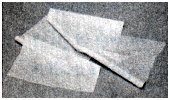 |
||
| Breathing Bag (Perc Bag®) | A two or three liter plastic bag with a mouthpiece, used to increase lung capacity and to avoid pulmonary complications, Stage I. Substitute a soft balloon or a surgical glove with a mouthpiece. | 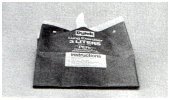 |
||
| Exercise putty (Theraplast®) | Elastic putty used in Stage I to strengthen and coordinate hands and fingers. You can substitute clay or Silly Putty. | 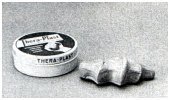 |
||
| Sponge ball | A lightweight sponge ball about 4 inches (10 cm) in diameter. Used in Stage I for general limbering, strengthening and coordination exercises. | 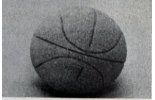 |
||
| Clothespin | An ordinary wooden clothespin, used in Stage I to coordinate hands and fingers. For added resistance, wrap a rubber band around the clothespin's tip. | 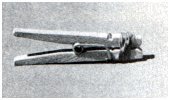 |
||
| Ankle weight | A 3-pound (1kg) ankle weight with a Velcro closure used for added resistance in Stage II general strengthening exercises. Substitutions: 1)Purchase sinkers from a fish and tackle store and pin or sew them to heavy material. Purchase Velcro from a sewing department. 2) Put canned goods in an old purse with a handle. 3) Sew sandbags. | 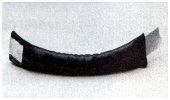 |
||
| Exercise stretcher | An elastic rope with looped handles, used in Stage II exercises for strengthening and stretching the large muscles. You can construct a stretcher from elastic shock cord, available in outdoor supply stores. Make loops at the end by tying knots. You can substitute a piece of surgical rubber Penrose® drain. | 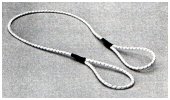 |
||
| Jump rope | Any type of jump rope will suffice. If you are bed bound you can tie the rope to the foot of the bed and use it to pull yourself to a sitting position. Also used in jump-rope exercises. You can substitute a piece of rope or clothesline. | 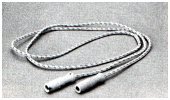 |
||
Stage I exercises are simple range-of-motion exercises that require little exertion and can be done when you are bedridden. Even if you are very ill you will probably be able to do some of these exercises. Remember it is important to exercise in order to maintain your muscle tone and your joint mobility.
All of these exercises are done lying on your back in bed. Since some of the exercises require you to bring your arms over your head, you may want to move down a little toward the end of the bed to give yourself more room behind your head. If you are in a hospital bed, raising the head of the bed about one-third of the way up will give you room to bring your arms back over your head without having to move down in the bed.
Try to exercise twice a day, more if you feel like it. Exercise whenever you feel best, for example, right after a nap or after pain medication. Start with three to five repetitions of each exercise and work up to 10 to 20 repetitions. Remember, if your muscles become tired or painful, stop and rest. Omit exercises that seem too difficult - try them again another day. Repeat only one or two of a series if you are tired, and rest before proceeding.
Begin each exercise session with a deep breathing exercise. Deep breathing is also a good way to rest between other exercises.
Exercise safely. Have someone present to assist you if possible. Having someone there with you will also make exercising more enjoyable.
Go to Stage I: Beginning To Move Rehabilitation Exercises
Stage II: Increasing Physical Activity
You are ready for Stage II when you can spend part of the day out of bed sitting in a chair and when you can do ten to twenty repetitions of Stage I exercises with ease. Since some Stage II exercises use a three-pound weight for added resistance to strengthen muscles, you should also feel you can take this added weight.
As in Stage I, try to exercise twice a day. Start with three to five repetitions of each exercise and work up to ten to twenty repetitions.
Some of the exercises require you to bring your arms over your head, you may want to move down a little toward the end of the bed to give yourself more room behind your head. If you are in a hospital bed, raising the head of the bed about one-third of the way up will give you room to bring your arms back over your head without having to move down in the bed.
Remember, if your muscles become tired or painful, stop and rest. Omit exercises that seem too difficult - try them again another day. Omit exercises that seem too difficult or do them without weights. Repeat only one or two of a series if you are tired, and rest before proceeding.
Exercise safely. Attach equipment securely. Have someone present to assist you if possible. Having someone there with you will also make exercising more enjoyable.
Breathing becomes even more important when you are lifting weights of any kind because the amount of pressure you put on your heart is increased if you hold your breath. Be sure to breathe in or blow out rhythmically throughout all these exercises. Begin each exercise with a deep breathing exercise. Deep breathing is also a good way to rest between exercises.
Go to Stage II: Increasing Physical Activity
Once you start spending the whole day out of bed, walking around the house, and resuming some of your normal daily activities, you are ready for Stage III exercises. These are vigorous exercises, and safety precautions should be observed when using a chair. Take your pulse when you begin and after you finish. It should return to resting pulse within five minutes. and so it is recommended that you watch your vital signs as you do them. Take your pulse when you begin and after you finish; it should return to its original rate within five minutes of finishing the exercise.
Try to exercise four to five times a week; and in the same way as with Stages I and II, begin with three to five repetitions of each exercise, and work up to ten to twenty repetitions.
Once again, especially with vigorous exercise routines like the following group, proper breathing is very important. Be careful not to hold your breath. Breathe in or blow out during all the exercises.
Go to Stage III: Up And Around
- A regular exercise program will keep your body fit and is good for your spirits as well. When you are able to do Stage III
exercises comfortably, think of adding some sports and recreational activities to your exercise program. You can work up to these gradually:
-
Climb stairs four or five times daily.
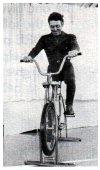
Take walks. Pace yourself: go one block the first time and then try to increase your distance daily.
Gardening is an excellent exercise if you enjoy it. At first someone may have to assist you with the heavier work. Even a small plot will provide you with exercise plus fresh air, sunshine, and a sense of accomplishment.
Bicycle. Plan your routes to be more or less strenuous to fit your needs.
Jumping rope is vigorous exercise that gives overall muscle toning and coordination.
Swim or, if our if you feel energetic, join a health club and make use of the saunas and steam room as well as the pool. Water is much easier to exercise in because it supports your limbs and makes it easier to move about.
|
You are welcome to share this © article with friends, but do not forget to include the author name and web address. Permission needed to use articles on commercial and non commercial websites. Thank you. |